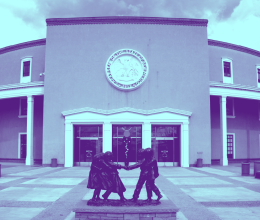
At the beginning of the COVID-19 pandemic, senior officials under former President Donald Trump seized upon an obscure public health rule as their latest tool for achieving an objective they had been trying for years to accomplish: shutting down the asylum system. On March 20, 2020, under pressure from the White House, the Centers for Disease Control and Prevention issued a mass migrant expulsion order under a legal provision that came to be known as “Title 42.” The order told border officials that they could expel people seeking safety in the United States without giving them any opportunity to explain their fears, even though U.S. law guarantees the right to seek asylum, and prohibits sending people to places they will be persecuted or tortured.
In the two years it's been in effect, Title 42 has had a devastating impact on people seeking safety in this country. Since March 2020, the government has misused the health order to kick out people seeking asylum more than 1.7 million times.
The CDC is set to again determine by March 30 if it will extend Title 42 or if the health order, never justified by science and in constantly-increasing tension with the Biden administration’s response to the COVID-19 pandemic, will finally expire.
Here’s what you need to know about Title 42:
1. It’s not really about COVID-19 — it’s about stopping people seeking refuge in the U.S.
COVID-19 was not the first time the Trump administration explored using public health as an excuse to shut down legal migration. Stephen Miller, Trump’s advisor who has pushed white nationalist stories and ideas, first suggested a shutdown of migration for health reasons in 2018. He floated the idea again in 2019 during a mumps outbreak.
He finally got his way in 2020 over the objections of many top scientists at the CDC, who according to the Associated Press saw “no valid public health reason to issue” the order.
The policy, nicknamed the “Stephen Miller special” by a former Trump administration official, has been criticized by leading epidemiologists and public health experts from the start. Earlier this year, a group of experts called on the Biden administration to “end its use of the scientifically-baseless Title 42 policy” which, they said, does not help prevent the spread of COVID-19 and “if anything, makes matters worse.”
“We are profoundly disappointed that the Biden administration continues to disregard science in favor of a cruel and discriminatory policy that does nothing to safeguard public health,” Dr. Michele Heisler, medical director of Physicians for Human Rights, said in a statement.
Even Dr. Anthony Fauci, one of the country’s leading COVID-19 experts, has said that expelling migrants “is not the solution to an outbreak.”
2. Title 42 has made it impossible for people seeking asylum to do so in a safe and orderly way.
Under Title 42’s mass expulsion policy, people seeking safety can be immediately removed from the United States with no consideration of their claims for protection. Depending on their nationality, they are either simply sent back across the border to Mexico — as has happened to thousands of Haitians — or they are sent back to their countries of origin.
People expelled to Mexico are stranded in unfamiliar cities, far from family, friends, and support networks in the U.S., relying on overburdened shelters and migrant aid organizations. Organized criminal groups, seeing the vulnerabilities of people cast adrift by the U.S. Border Patrol, often prey on them.
Under the Biden administration, the nonprofit Human Rights First has documented nearly 10,000 cases in which people blocked from seeking asyum by Title 42 in the U.S. have been kidnapped, tortured, raped and violently attacked in Mexico. Many more cases go unreported and untracked.
Under the Biden administration, nearly 14,000 Haitians have been expelled under Title 42, according to the human rights organization WOLA. They’ve arrived to a country still reeling from devastating earthquakes and political turmoil — a country the U.S. knows is in no position to safely receive them.
3. The U.S. government can take steps now to prepare to handle asylum requests when the policy is lifted
Some people who need asylum but were turned away under Title 42 will likely try to again seek safety and asylum in the U.S. when the policy is lifted. This is a predictable response to the U.S. government creating a backlog of people at the border seeking protection who were blocked from doing so for years through Title 42 and other restrictive policies.
Even while it has kept Title 42 in place, the Biden administration has claimed that it remains committed to rebuilding the asylum system. Officials have had more than a year to put in place the infrastructure necessary to efficiently and humanely process people seeking safety at our borders. That includes staffing and training asylum officers as needed. CBP officers should not be involved in the screening to assess a person's fear of returning to their home country or their intent to apply for asylum. And, to the extent more work remains to be done, it can and should be a priority for the government to complete it.
4. CBP is capable of processing people seeking asylum in the U.S.
The Department of Homeland Security has a multi-billion dollar budget. Its border agency just got a billion-dollar increase to enhance its processing capacity. It has the resources needed to fulfill its responsibilities and process people who seek asylum at the border.
To be clear, CBP shouldn’t simply go back to its old methods when Title 42 ends. That would be both cruel and wasteful. For example, instead of holding vulnerable people seeking protection in inhumane conditions for periods well beyond the time limits set by the agency’s own guidelines, the agency can and should only hold people for the few hours it takes for processing.
The agency can also, as it did in 2019, issue its own release paperwork without waiting on partner agencies to do so, further decreasing the time people are held in CBP facilities. Allowing people seeking asylum to stay with family, friends, and other sponsors while their immigration cases are processed avoids needless detention, gives people a fairer shot at making their asylum case, and makes the entire system work more smoothly and efficiently.
5. Title 42 has been declared unlawful by the courts — and by one of the government's top lawyers.
In early March, a federal court in D.C. issued a unanimous ruling in a case brought by the ACLU and partners challenging Title 42 expulsions. The court recognized the grave dangers faced by those subject to Title 42 and ruled that it is unlawful for the government to expel people without first ensuring they will not be returned to torture or persecution.
The court also forcefully questioned the policy’s public health justification, noting that it "looks in certain respects like a relic from an era with no vaccines, scarce testing, few therapeutics, and little certainty."
At least one top legal official in the Biden administration has also condemned the “Stephen Miller Special” as unlawful. Shortly before leaving the administration, Harold Koh, a senior adviser in the State Department, wrote a memo dated Oct. 2 calling the use of Title 42 to expel people “illegal” and “inhumane.” He emphasized that “lawful, more humane alternatives plainly exist.”
The order runs counter to U.S. laws governing the fair and orderly processing of people seeking asylum in the country. It also runs counter to the letter and spirit of treaties and international agreements made by the U.S. in the aftermath of the horrors of World War II.

